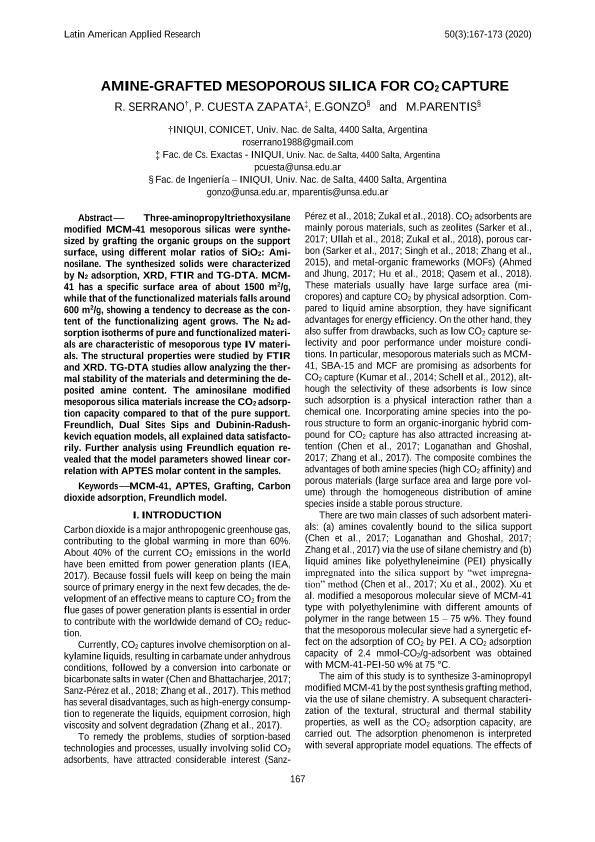Artículo
Amine grafted mesoporous silica por CO2 capture
Serrano, Melisa Romina ; Cuesta Zapata, Pablo Martín
; Cuesta Zapata, Pablo Martín ; Gonzo, Elio Emilio
; Gonzo, Elio Emilio ; Parentis, Monica Liliana
; Parentis, Monica Liliana
 ; Cuesta Zapata, Pablo Martín
; Cuesta Zapata, Pablo Martín ; Gonzo, Elio Emilio
; Gonzo, Elio Emilio ; Parentis, Monica Liliana
; Parentis, Monica Liliana
Fecha de publicación:
29/03/2020
Editorial:
Universidad Nacional de Jujuy. Facultad de Ingeniería. Planta Piloto de Ingeniería Química
Revista:
Latin American Applied Research
ISSN:
0327-0793
e-ISSN:
1851-8796
Idioma:
Inglés
Tipo de recurso:
Artículo publicado
Clasificación temática:
Resumen
Three-aminopropyltriethoxysilane modified MCM-41 mesoporous silicas were synthesized by grafting the organic groups on the support surface, using different molar ratios of SiO2:Aminosilane. The synthesized solids were characterized by N2 adsorption, XRD, FTIR and TG-DTA. MCM-41 has a specific surface area of about 1500 m2/g, while that of the functionalized materials falls around 600 m2/g, showing a tendency to decrease as the content of the functionalizing agent grows. The N2 adsorption isotherms of pure and functionalized materials are characteristic of mesoporous type IV materials. The structural properties were studied by FTIR and XRD. TG-DTA studies allow analyzing the thermal stability of the materials and determining the deposited amine content. The aminosilane modified mesoporous silica materials increase the CO2 adsorption capacity compared to that of the pure MCM-41. The results obtained are well interpreted by Freundlich physicochemical model and the model parameters show a linear correlation with APTES molar content in the samples.
Palabras clave:
MCM-41
,
APTES
,
GRAFTING
,
CARBON DIOXIDE ADSORPTION
,
FREUNDLICH MODEL
Archivos asociados
Licencia
Identificadores
Colecciones
Articulos(INIQUI)
Articulos de INST.DE INVEST.PARA LA INDUSTRIA QUIMICA (I)
Articulos de INST.DE INVEST.PARA LA INDUSTRIA QUIMICA (I)
Citación
Serrano, Melisa Romina; Cuesta Zapata, Pablo Martín; Gonzo, Elio Emilio; Parentis, Monica Liliana; Amine grafted mesoporous silica por CO2 capture; Universidad Nacional de Jujuy. Facultad de Ingeniería. Planta Piloto de Ingeniería Química; Latin American Applied Research; 50; 3; 29-3-2020; 167-173
Compartir
Altmétricas



